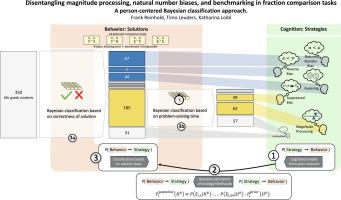Contemporary Educational Psychology ( IF 10.3 ) Pub Date : 2023-09-06 , DOI: 10.1016/j.cedpsych.2023.102224 Frank Reinhold , Timo Leuders , Katharina Loibl

|
Research on fraction comparison shows that students often follow biased comparison strategies, in particular such strategies that build on their knowledge of natural numbers. On the other hand they also apply successful comparison strategies such as benchmarking or fraction magnitude processing. Which strategies are applied or even combined depends on the students’ knowledge and on the task type. To investigate these complex relationships, we developed a balanced 2 × 2-dimensional itemset (congruent vs. incongruent items; benchmarking vs. non-benchmarking items) and a Bayesian classification of individual students’ performance (solution patters, response time, and individual distance effect), which we applied to an assessment of N = 350 sixth graders. We could show that the classification of the students with respect to possible solution strategies matched our hypotheses: We could replicate existing patterns and found additional composite strategies such as ‘benchmarking or bias‘ with a bias only in solution rates of non-benchmark items. In further analyses we found ‘benchmarking or suppressed bias-strategies (i.e., a bias in problem solving time of non-benchmarking items). Our study extends previous knowledge on individual strategies in fraction comparison and proposes a new person-centered approach to classify individual student profiles even with small profile sizes.
中文翻译:

解开分数比较任务中的幅度处理、自然数偏差和基准测试:以人为中心的贝叶斯分类方法
对分数比较的研究表明,学生经常遵循有偏见的比较策略,特别是基于自然数知识的策略。另一方面,他们还应用了成功的比较策略,例如基准测试或分数幅度处理。应用甚至组合哪些策略取决于学生的知识和任务类型。为了研究这些复杂的关系,我们开发了一个平衡的 2 × 2 维项目集(一致与不一致的项目;基准测试与非基准测试项目)以及个别学生表现的贝叶斯分类(解决方案模式、响应时间和个人距离)效应),我们将其应用于N的评估 = 350 名六年级学生。我们可以证明学生对可能的解决方案策略的分类符合我们的假设:我们可以复制现有模式并找到其他复合策略,例如“基准或偏差”,仅在非基准项目的解决率上存在偏差。在进一步的分析中,我们发现了“基准测试或抑制偏差策略”(即非基准测试项目的问题解决时间偏差)。我们的研究扩展了先前关于分数比较中个人策略的知识,并提出了一种新的以人为中心的方法,即使个人资料尺寸较小,也可以对个人学生资料进行分类。



























 京公网安备 11010802027423号
京公网安备 11010802027423号